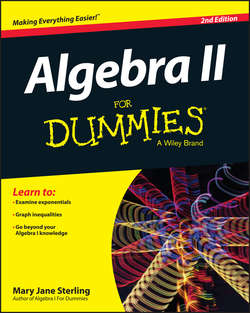Читать книгу Algebra II For Dummies - Sterling Mary Jane - Страница 8
На сайте Литреса книга снята с продажи.
Part I
Homing in on Basic Solutions
Chapter 1
Going Beyond Beginning Algebra
Expounding on Exponential Rules
ОглавлениеSeveral hundred years ago, mathematicians introduced powers of variables and numbers called exponents. The use of exponents wasn’t immediately popular, however. Scholars around the world had to be convinced; eventually, the quick, slick notation of exponents won over, and we benefit from the use today. Instead of writing xxxxxxxx, you use the exponent 8 by writing x8. This form is easier to read and much quicker.
The expression an is an exponential expression with a base of a and an exponent of n. The n tells you how many times you multiply the a times itself.
You use radicals to show roots. When you see , you know that you’re looking for the number that multiplies itself to give you 16. The answer? Four, of course. If you put a small superscript in front of the radical, you denote a cube root, a fourth root, and so on. For instance, , because the number 3 multiplied by itself four times is 81. You can also replace radicals with fractional exponents – terms that make them easier to combine. This use of exponents is very systematic and workable – thanks to the mathematicians that came before us.
Multiplying and dividing exponents
When two numbers or variables have the same base, you can multiply or divide those numbers or variables by adding or subtracting their exponents:
✔ : When multiplying numbers with the same base, you add the exponents.
✔ : When dividing numbers with the same base, you subtract the exponents (numerator – denominator). And, in this case, .
Also, recall that a0 = 1. Again, . To multiply , for example, you add the exponents: x4 + 5 = x9. When dividing x8 by x5, you subtract the exponents: . You must be sure that the bases of the expressions are the same. You can multiply 32 and 34, but you can’t use the rule of exponents when multiplying 32 and 43.
Getting to the roots of exponents
Radical expressions – such as square roots, cube roots, fourth roots, and so on – appear with a radical to show the root. Another way you can write these values is by using fractional exponents. You’ll have an easier time combining variables with the same base if they have fractional exponents in place of radical forms:
✔ : The root goes in the denominator of the fractional exponent.
✔ : The root goes in the denominator of the fractional exponent, and the power goes in the numerator.
So, you can say and so on, along with .
To simplify a radical expression such as , you change the radicals to exponents and apply the rules for multiplication and division of values with the same base (see the previous section):
Raising or lowering the roof with exponents
You can raise numbers or variables with exponents to higher powers or reduce them to lower powers by taking roots. When raising a power to a power, you multiply the exponents. When taking the root of a power, you divide the exponents:
✔ (am)n = am · n: Raise a power to a power by multiplying the exponents.
✔ : Reduce the power when taking a root by dividing the exponents.
The second rule may look familiar – it’s one of the rules that govern changing from radicals to fractional exponents (see Chapter 4 for more on dealing with radicals and fractional exponents).
Here’s an example of how you apply the two rules when simplifying an expression:
Making nice with negative exponents
You use negative exponents to indicate that a number or variable belongs in the denominator of the term:
and
Writing variables with negative exponents allows you to combine those variables with other factors that share the same base. For instance, if you have the expression , you can rewrite the fractions by using negative exponents and then simplify by using the rules for multiplying factors with the same base (see “Multiplying and dividing exponents”):
